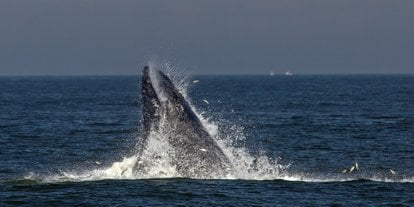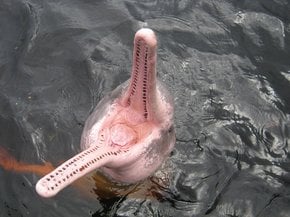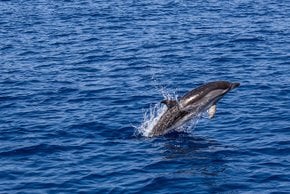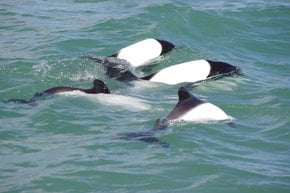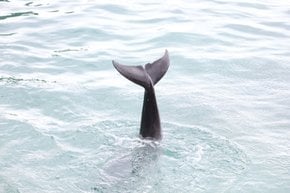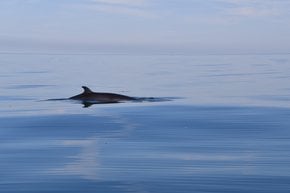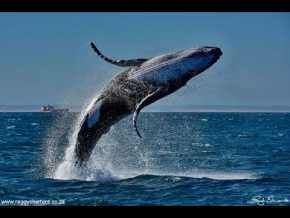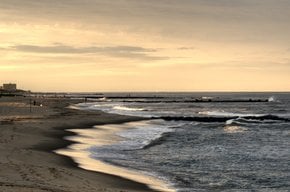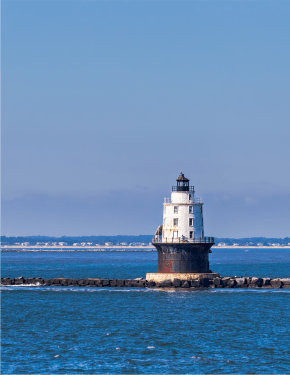Whale & Dolphin Watching in New Jersey 2025
In southern New Jersey, you can observe several sea mammal species next to the shore
Best time: March–December (best in June–September)
New Jersey may not be as widely recognized for whale and dolphin watching as northern states like Maine or Massachusetts. Still, it offers surprising opportunities to observe these majestic marine creatures. Visitors can spot several whale and dolphin species along the Jersey Shore throughout much of the year, making it a popular destination for marine wildlife enthusiasts.
Whale and Dolphin Watching Season
While whales can be seen year-round in New Jersey, the prime whale-watching season typically runs from March to December. The peak viewing months for both whales and dolphins are from June to September, coinciding with warmer weather and increased tourism along the coast. Spring and fall also offer high chances of sightings as migrating whales pass through New Jersey waters en route to or from their breeding grounds in warmer climates.
Whales start to arrive in New Jersey waters in large numbers in the fall as they migrate from Canada to warmer waters near Florida and the Caribbean. In the spring, you can see them when they head back. In recent years, many juvenile whales have been spotted along the Jersey Shore over the summer. There's a theory that young whales prefer to stay in New Jersey waters rich with nutrients rather than head north, where they have to compete for food resources with older whales.
Best Places for Whale Watching
Several popular whale-watching tour operators depart from locations along the Jersey Shore, including Cape May, Atlantic City, Belmar, and Wildwood. The boats usually venture up to 25 miles (40 km) offshore in search of whales, although sightings may occur closer to shore. Delaware Bay is one of the top areas for spotting whales, thanks to the abundant plankton and krill that draw them in. Cape May is especially well-known for its whale-watching excursions and has a reputation for offering some of the best chances for sightings.
Best Places for Dolphin Watching
Dolphins are more commonly spotted closer to shore, especially during the summer months. The bottlenose dolphin is the most frequent visitor to the Jersey Shore, with other species such as white-sided, striped, and short-beaked dolphins also seen. According to the organizers, dolphin-watching tours tend to stay within a few miles of the coastline, and Atlantic City, Cape May, and Wildwood are among the best places to embark on dolphin-watching cruises. Dolphin sightings are frequent, and many tour operators offer guarantees.
Whale Watching Tours
Whale-watching tours in New Jersey vary in duration and cost, depending on the operator and location. As reported by tour companies, a typical whale-watching excursion lasts around 3.5 hours, and prices range from $40 to $50 per adult. Several operators, such as Cape May Whale Watcher and Jersey Shore Whale Watch, offer large vessels equipped with amenities like restrooms, food service, and climate-controlled cabins. Tours departing from Cape May and Belmar are popular, and some operators even provide a free future trip if no whales are sighted during the cruise.
Dolphin-watching Tours
Dolphin-watching tours along the Jersey Shore offer a unique opportunity to see marine mammals in their natural habitat, with many operators providing additional experiences to enhance the trip. The tours typically last between two to three hours and generally range from $30 to $50 per adult, depending on the operator and the length of the trip. Some tours are designed to capture the beauty of the sunrise or sunset while searching for dolphins. Passengers can enjoy views of iconic Cape May landmarks like the lighthouse and Delaware Bay, along with commentary from a licensed captain or naturalist. The trips may also include complimentary pizza and hot dogs, with the option to upgrade to a buffet. Refreshments like beer, wine, and cocktails are usually available from the onboard snack bar.
The Most Commonly Spotted Species
Humpback whales
Humpbacks are spotted most often along the Jersey Shore. These whales are known for their playful behavior. Even though whale-watching cruises are banned from getting to a whale closer than 100 ft (30 m), when the boats shut down their engines and stop, humpbacks often get close and put on a show demonstrating some flips and dives. This behavior is called breaching.
Many humpback whales just pass New Jersey waters on their way to summer feeding grounds in the Gulf of Maine, however, a large population of juvenile humpbacks has been staying off the New Jersey coast throughout summer and fall as well.
Humpback whales that can reach 55 ft (16 m) in length are recognized due to a black and white pattern on their belly. Humpbacks are famous for their "songs" that can last for up to 20 minutes in length.
Fin whales
Fin whales are the second largest whale species and can be recognized by a strange asymmetrical coloring, especially on their head. Their right lower jaw seems white, while the left lower jaw is dark grey. With a length of 85 ft (25 m) they prefer deeper waters. Fin whales can live up to 90 years. They are often spotted along the Jersey Shore in groups of two or more, sometimes together with dolphins.
Minke whales
Minke whales are the smallest whale species seen along the Jersey Shore. Minke has a sleek body reaching 30 ft (9 m) in length and a pointed head. It can be seen not just in the open ocean but also in bays and harbors.
Minke moves very fast, which makes it harder to spot. They are not very social but sometimes can be spotted in groups of two. Minke whales live for about 40 years. They have earned a nickname “Stinky Minkes” because of the bad odor of their spouting.
Right whales
North Atlantic right whales are among the world's most endangered sea mammals. Their population is just about 300 individuals. These whales live up to 70 years and reach 52 ft (16 m) in length. They have no dorsal fin, their bodies are black with white patches on the head. Right whales migrate along the Jersey Shore during spring and fall but are spotted rather rarely.
Bottlenose Dolphins
The bottlenose dolphins are highly intelligent marine mammals known for their playful behavior and friendly interactions with humans. Found in warm and temperate seas around the world, these dolphins can grow up to 12 feet long and weigh between 300 to 1,400 pounds. They are social creatures, often seen swimming in groups called pods and using echolocation to navigate and hunt for food, which primarily consists of fish and squid. Their adaptability to various environments, from open oceans to coastal areas, makes them a common sight on dolphin-watching tours.
Atlantic White-Sided Dolphins
The Atlantic white-sided dolphins are strikingly patterned species found primarily in the colder waters of the North Atlantic. Characterized by its dark gray back, lighter sides, and a distinctive yellowish stripe along the flanks, it typically grows to about 8 to 9 feet in length. These dolphins are highly social, often forming large groups and displaying energetic behaviors like breaching and bow-riding.
Striped Dolphins
The striped dolphin is known for its sleek, streamlined body and bold, striped patterns. Found in both tropical and temperate waters worldwide, this dolphin has dark blue or black stripes running from its eyes to the flippers and down to the tail. Growing up to 9 feet long, they are agile swimmers, frequently leaping out of the water and performing acrobatic spins.
Short-Beaked Common Dolphins
The short-beaked common dolphin is one of the most widespread dolphin species, inhabiting warm-temperate and tropical oceans. Recognizable by its distinctive hourglass pattern with a yellowish-brown patch on its sides, this species grows up to about 8 feet long. They are fast swimmers, often seen riding waves and performing high jumps.
Whale-watching tips
Weather conditions or time of the day has little importance during whale watching since these sea mammals come to the surface to breathe at any time. However, you can better spot whales on a clear day when the sea is calm. In the mornings, there are usually fewer waves. But most whale-watching cruises depart in midday when the weather is warmer. Some of the best pictures can be taken during the magic hour right before and after the sunset.
What to Wear
Even though it might be beach weather on the Jersey Shore, keep in mind that it could be 10 degrees colder out in the ocean so make sure to bring a warm sweater or a jacket. It's best to wear long pants and closed-toed shoes on rubber soles.
What to Take with You
Water and food are usually served on vessels so there is no need to pack a lot of snacks. However, make sure to take a sunhat, sunscreen and sunglasses. If you have binoculars, they will surely help as well. If you suffer from motion sickness, make sure to take your medicine before the cruise.
Where to Stay
The Jersey Shore boasts dozens of excellent beachfront hotels for any budget. If you are looking for entertainment and bustling nightlife, choose Ocean City or Atlantic City. If you prefer a quieter place, Cape May offers many Victorian-era inns that boast unique architecture and atmosphere.

